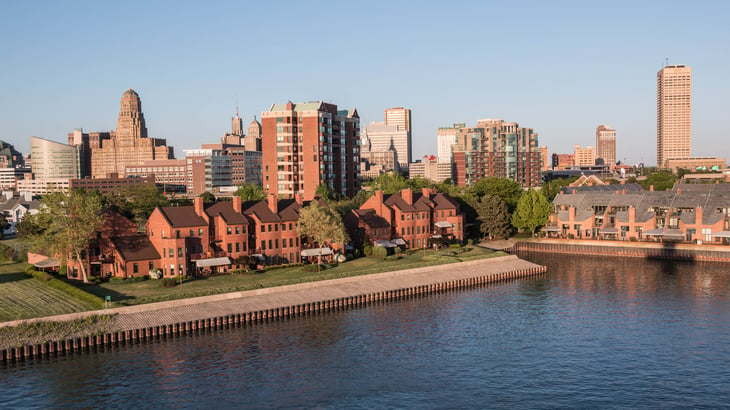
Editor’s Note: This story originally appeared on Construction Coverage.
The red-hot pandemic housing market has finally cooled in recent months. Due to actions by the Federal Reserve to combat inflation, mortgage rates have more than doubled from the historic lows seen in 2021.
As a result, home sales have slowed dramatically, and prices have started to come down. However, housing markets in some parts of the country tend to be less stable and more prone to volatility than others.
As potential buyers weigh their options in this market, it is helpful to consider how different locations have fared historically during periods of volatility.
To determine the locations with the most stable housing markets, researchers at Construction Coverage analyzed the latest data from Zillow. The researchers ranked metros according to the chance of a random buyer experiencing at least a 5% price drop, using data from 2000 to present.
For each location, researchers also calculated the largest price drop from 2000 to present, the current median home price, and the percentage change in home price from 2000 to present.
Find details on our methodology at the end. Here are the U.S. metropolitan areas with the most stable housing markets.
15. Virginia Beach-Norfolk-Newport News, VA-NC

- Chance of experiencing a 5% price drop (2000-present): 24.2%
- Largest price drop (2000-present): $49,198
- Median home price (present): $334,319
- Percentage change in home price (2000-present): 171%
14. Louisville/Jefferson County, KY-IN

- Chance of experiencing a 5% price drop (2000-present): 22.7%
- Largest price drop (2000-present): $12,831
- Median home price (present): $243,782
- Percentage change in home price (2000-present): 116%
13. Raleigh-Cary, NC

- Chance of experiencing a 5% price drop (2000-present): 21.2%
- Largest price drop (2000-present): $30,661
- Median home price (present): $448,553
- Percentage change in home price (2000-present): 156%
12. New Orleans-Metairie, LA

- Chance of experiencing a 5% price drop (2000-present): 21.2%
- Largest price drop (2000-present): $26,049
- Median home price (present): $270,020
- Percentage change in home price (2000-present): 121%
11. Salt Lake City, UT

- Chance of experiencing a 5% price drop (2000-present): 20.9%
- Largest price drop (2000-present): $78,455
- Median home price (present): $582,222
- Percentage change in home price (2000-present): 212%
10. Nashville-Davidson–Murfreesboro–Franklin, TN

- Chance of experiencing a 5% price drop (2000-present): 20.9%
- Largest price drop (2000-present): $26,081
- Median home price (present): $452,985
- Percentage change in home price (2000-present): 215%
9. Washington-Arlington-Alexandria, DC-VA-MD-WV

- Chance of experiencing a 5% price drop (2000-present): 19.8%
- Largest price drop (2000-present): $135,255
- Median home price (present): $550,214
- Percentage change in home price (2000-present): 188%
8. Houston-The Woodlands-Sugar Land, TX

- Chance of experiencing a 5% price drop (2000-present): 19.4%
- Largest price drop (2000-present): $16,123
- Median home price (present): $314,051
- Percentage change in home price (2000-present): 149%
7. Urban Honolulu, HI

- Chance of experiencing a 5% price drop (2000-present): 16.1%
- Largest price drop (2000-present): $97,356
- Median home price (present): $928,450
- Percentage change in home price (2000-present): 271%
6. Tulsa, OK

- Chance of experiencing a 5% price drop (2000-present): 15.0%
- Largest price drop (2000-present): $9,399
- Median home price (present): $217,564
- Percentage change in home price (2000-present): 115%
5. San Antonio-New Braunfels, TX

- Chance of experiencing a 5% price drop (2000-present): 11.0%
- Largest price drop (2000-present): $15,889
- Median home price (present): $340,353
- Percentage change in home price (2000-present): 160%
4. Austin-Round Rock-Georgetown, TX

- Chance of experiencing a 5% price drop (2000-present): 10.3%
- Largest price drop (2000-present): $38,559
- Median home price (present): $549,232
- Percentage change in home price (2000-present): 210%
3. Oklahoma City, OK

- Chance of experiencing a 5% price drop (2000-present): 0.0%
- Largest price drop (2000-present): $5,304
- Median home price (present): $222,360
- Percentage change in home price (2000-present): 143%
2. Buffalo-Cheektowaga, NY

- Chance of experiencing a 5% price drop (2000-present): 0.0%
- Largest price drop (2000-present): $4,535
- Median home price (present): $244,001
- Percentage change in home price (2000-present): 163%
1. Pittsburgh, PA

- Chance of experiencing a 5% price drop (2000-present): 0.0%
- Largest price drop (2000-present): $3,892
- Median home price (present): $209,084
- Percentage change in home price (2000-present): 136%
Methodology

To determine the U.S. metropolitan areas with the most stable housing markets, researchers at Construction Coverage analyzed the latest data from Zillows’ Zillow Home Value Index (ZHVI), a measure of typical home value.
The researchers ranked metros according to the probability that a random buyer purchasing a home at any point between 2000 and present would have experienced a greater-than-5% price drop following the purchase.
In the event of a tie, the metro with the largest price drop from 2000 to present was ranked higher. Researchers also calculated the current median home price — using the most recent ZHVI — and the percentage change in home price from 2000 to present.
Metros missing three or more consecutive months of ZHVI data were excluded from the analysis. For metros missing one or two consecutive months of data, missing values were imputed using an average of the ZHVI for the months immediately before and after.
To improve relevance, only metropolitan areas with at least 100,000 people were included in the analysis.
